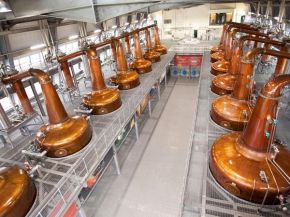Scotland reports drop in air pollution as emissions continue to fall
by ClickGreen staff. Published Fri 11 Sep 2015

A new report published today shows Scottish emissions of most air
pollutants have continued to fall, with significant reductions in
emissions of all air pollutants since 1990.
The announcement of the official figures was welcomed by Environment
Minister Aileen McLeod who said an updated action
plan to tackle nitrogen dioxide would soon be
published.
Dr McLeod said: “Air pollution is harmful to human health and can
contribute to climate change, and I very much welcome the
significant progress that has been made reducing emissions of
nitrogen oxides and other air pollutants in Scotland.
“However, more needs to be done. The Scottish Government is already
working closely with local authorities and other partners to improve
air quality and the lives and well-being of communities and
individuals across the country.
“Local authorities with air quality issues in their areas have in
place local action
plans to improve the situation which can include
measures such as promoting of walking and cycling, for example, or
greater use of cleaner vehicles. And the forthcoming national Low
Emission Strategy – which we consulted on earlier this year - will
ensure greater consistency in approach across Scotland.
“We will also shortly be holding another
consultation on updated action plans for ensuring
compliance with EU nitrogen dioxide targets.”
The main findings of today’s report released by Scotland’s Chief
Statistician include:
* Over the long term there have been reductions in emissions for all
the pollutants. Since 1990, there have been decreases of 28 per cent
for ammonia, 53 per cent for PM10, 66 per cent for NMVOCs, 67 per
cent for nitrogen oxides, 81 per cent for carbon monoxide, 87 per
cent for sulphur dioxide and 99 per cent for lead.
In 2013:
* Ammonia – Scottish emissions accounted for 12 per cent of UK
emissions. The main source of Scottish emissions was agriculture
responsible for 87 per cent of emissions.
* PM10 – Scottish emissions accounted for 11 per cent of UK
emissions. Thirty five per cent of Scottish emissions came from
commercial, domestic and agricultural combustion, 21 per cent from
agriculture and 16 per cent from transport sources.
* Nitrogen oxides – Scottish emissions accounted for 9 per cent of
UK emissions. Transport sources accounted for 38 per cent of
Scottish emissions, energy industries 35 per cent and industrial
combustion 13 per cent.
* NMVOCs – Scottish emissions accounted for 17 per cent of UK
emissions. Industrial processes (mainly breweries and distilleries)
accounted for 47 per cent of Scottish emissions, solvents and other
product use 20 per cent and fugitive emissions from fuels 15 per
cent.
* Sulphur dioxide – Scottish emissions accounted for 10 per cent of
UK emissions. Seventy nine per cent of Scottish emissions came from
power generation, 8 per cent from industrial combustion and 7 per
cent from commercial, domestic and agricultural combustion.
* Carbon monoxide – Scottish emissions accounted for 8 per cent of
UK emissions. Commercial, domestic and agricultural combustion
accounted for 38 per cent of Scottish emissions, transport 30 per
cent and 23 per cent came from industrial combustion.
* Lead – Scottish emissions accounted for 4 per cent of UK
emissions. Industrial combustion accounted for 31 per cent of
Scottish emissions, commercial, domestic and agricultural 28 per
cent and energy industries 21 per cent.
The 1990-2013 figures in this Statistics Release are from the NAEI
report “Air Quality Pollutant Inventories for England, Scotland,
Wales and Northern Ireland: 1990 – 2013”, produced by Aether and
Ricardo-AEA for the Scottish Government, the UK Department for
Environment, Food and Rural Affairs, the Welsh Assembly Government
and the Northern Ireland Department of Environment.
Emissions from the offshore oil and gas exploration sector are not
attributed to a specific country but are reported within an
“unallocated” category.
There are uncertainties associated with all estimates of pollutant
emissions. The uncertainty rating are “high” for ammonia, carbon
monoxide and PM10, “moderate” for NMVOCs and lead and “low” for
nitrogen oxides and sulphur dioxide. However, although for any given
year considerable uncertainties may surround the emission estimates,
it should be noted that trends over time are likely to be more
reliable.
Powered by
Click Creative
© All Rights Reserved.
http://www.clickgreen.org.uk/news/national-news/126455-scotland-reports-drop-in-air-pollution-as-emissions-fall.html